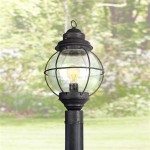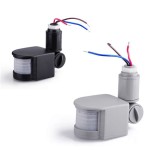Photocell Sensors for Outdoor Lighting
Outdoor lighting plays a crucial role in enhancing security, aesthetics, and functionality of residential and commercial properties. Photocell sensors, also known as light-sensitive switches, are essential components in modern outdoor lighting systems, enabling automatic activation and deactivation of lights based on ambient light levels. These sensors offer numerous advantages over manually controlled systems, including energy efficiency, enhanced safety, and increased convenience. This article will explore the workings of photocell sensors, their key benefits, and considerations for selecting and installing them.
How Photocell Sensors Work
Photocell sensors operate based on the principle of photoconductivity. They consist of a light-sensitive element, typically a cadmium sulfide (CdS) cell, which changes its electrical resistance depending on the intensity of light falling upon it. When the light level drops below a predefined threshold, the resistance of the CdS cell increases, triggering the activation of the connected lighting fixture. Conversely, when the light level rises above the threshold, the resistance decreases, turning off the light. The sensitivity of the sensor can be adjusted using a potentiometer, allowing for customization of the light level at which the sensor activates.
Benefits of Photocell Sensors
Photocell sensors offer several advantages over traditional manual lighting systems:
Energy Efficiency
Photocell sensors automatically activate lights only when necessary, eliminating the need for manual intervention and preventing unnecessary energy consumption. By ensuring that lights are only on when it's dark, these sensors significantly reduce electricity bills and minimize environmental impact. This is particularly beneficial in settings where lights are often left on for extended periods, such as streetlights, parking lots, and security lighting.
Enhanced Safety
Photocell sensors contribute to enhanced safety by automatically illuminating pathways and areas when it's dark, reducing the risk of accidents and incidents. This is particularly important in areas with limited visibility, such as stairwells, driveways, and pedestrian walkways. Automatic illumination also deters potential criminals by making the area more visible.
Convenience and Automation
Photocell sensors provide convenience by eliminating the need for manual switching of lights. They ensure that lights are always on when needed, without requiring any user intervention. This automation simplifies maintenance and reduces the risk of human error, particularly in locations that are difficult to access or require regular lighting adjustments.
Considerations for Selection and Installation
When choosing photocell sensors for outdoor lighting, it's important to consider several factors:
Sensor Type
Photocell sensors come in various types, including dusk-to-dawn, timer-based, and motion-activated. Each type has its own characteristics and suitability for specific applications. Dusk-to-dawn sensors activate lights when the ambient light level drops below a predefined threshold and turn them off when the light level rises above it. Timer-based sensors activate lights for a predetermined duration, often used for security or aesthetic purposes. Motion-activated sensors activate only when movement is detected, typically used for enhancing security.
Light Sensitivity
The light sensitivity of the sensor determines the ambient light level at which the sensor activates. It's crucial to choose a sensor with appropriate sensitivity based on the specific application and environmental conditions. For example, a sensor with high sensitivity might be suitable for streetlights, while a sensor with lower sensitivity might be more appropriate for residential lighting.
Installation Location
The location of the photocell sensor is critical for its performance. The sensor should be positioned in a location where it receives unobstructed views of the surrounding environment, avoiding any obstruction or interference from nearby lighting fixtures. The sensor should also be installed in a way that prevents water and dust ingress.
Conclusion
Photocell sensors are essential components in modern outdoor lighting systems, offering numerous advantages over traditional manual controls. By enabling automatic activation and deactivation of lights based on ambient light levels, these sensors enhance energy efficiency, safety, and convenience. When selecting and installing photocell sensors, it's crucial to consider the sensor type, light sensitivity, and installation location to ensure optimal performance and meet the specific requirements of the application.

Wall Mounted Photocell Sensor Outdoor Lighting

Hardwire Post Eye Light Control With Photocell Automatic Sensor Switch Ledwholers

120v Ac Photoelectric Switch Photocell Light Dusk To Dawn Sensor For Outdoor Lighting Hardwired Post Eye Control Fruugo Fi

How To Add A Light Sensor Outdoor Lanterns The Navage Patch

Ip54 Outdoor Light Sensor Switch Photocontrol China Photocell Control Made In Com

Solus Photocell Light Sensor Switch For Hardwire Outdoor Lamp Posts With Ezee Change Plug Dusk To Dawn Control

Light Control Socket With Photocell Sensor Outdoor True Value

240v Dusk To Dawn Sensor External Photocell Unit Lumena Lights

Outdoor Light Intensity Sensor Ahkf

Hardwire Post Eye Light Control With Photocell Automatic Sensor Switch Ledwholers
Related Posts








